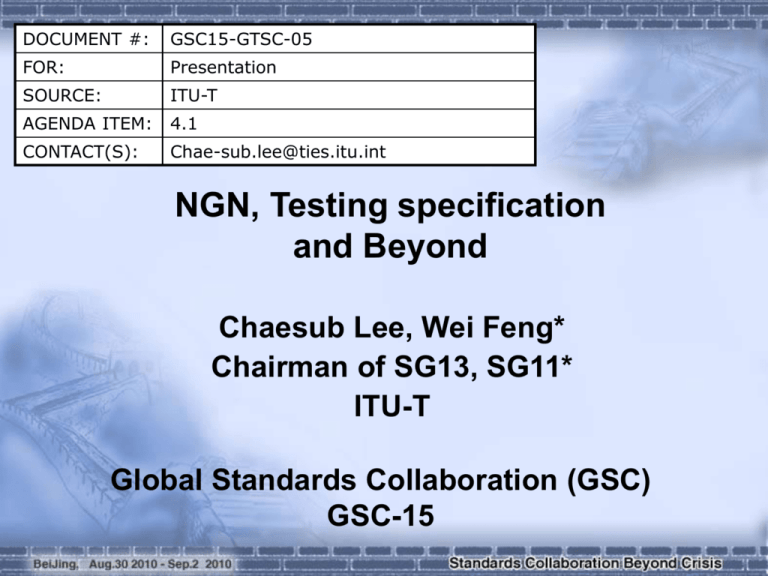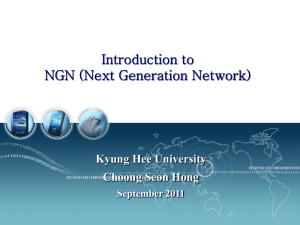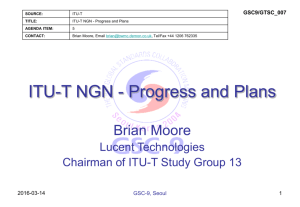ITU NGN,Testing specification and Beyond - GSC-15
advertisement

DOCUMENT #: GSC15-GTSC-05 FOR: Presentation SOURCE: ITU-T AGENDA ITEM: 4.1 CONTACT(S): Chae-sub.lee@ties.itu.int NGN, Testing specification and Beyond Chaesub Lee, Wei Feng* Chairman of SG13, SG11* ITU-T Global Standards Collaboration (GSC) GSC-15 Highlight of Current Activities Enhance Service capabilities: Voice based to Contents based Further development of functions for: Mobility, Multicast, Contents and IdM Applications ANI SNI Application Support Functions and Service Support Functions IdM Functions Service Control and Content Delivery Functions Management Functions Service User Profiles Service Control Functions Functions from other Service Providers Content Delivery Functions Service Stratum Network Attachment and Control Functions Transport User Profiles Mobility Management and Control Functions Resource and Admission control Functions Functions from Other Networks Transport Control Functions End-User Functions Transport Functions UNI NNI Transport Stratum Control Media Management IdM 2 Highlight of Current Activities NGN-GSI (Global Standards Initiative) events since the last GSC • Co-located SG 11 and 13 Meetings: Mar Del Plata, Argentina, 2 – 12 September 2009 Geneva, Switzerland, 19 - 30 April 2010 • Co-located Rapporteur group Meetings: Geneva, Switzerland, 18-29 January 2010 Key issues from NGN-JCA (Joint Coordination Activity) • • • • Revised ToR but not serious Harmonization among mobility-related Qs Support of Future Networks Interoperability Highlight on Testing Specification • 7 approved standards and 30 draft texts are underway. • Focus on services / QoS / Monitoring parameters / USN and NID / protocol areas 3 Unlimited Scope by ITU-T Definition (Y.2001) Next Generation Network (NGN): “A packet-based network able to provide telecommunication services and able to make use of multiple broadband, QoSenabled transport technologies and in which service-related functions are independent from underlying transport-related technologies. It enables unfettered access for users to networks and to competing service providers and/or services of their choice. It supports generalized mobility which will allow consistent and ubiquitous provision of services to users.” No restricted scope if use any types of Packet No limited time line whenever use any Packet 4 High Priority Issues in ICT Contribution to protect environments: e.g. Climate Change An important and fundamental social infrastructure for supporting On-line society: e-Everything (e.g. healthcare and education) A platform for leveraging convergences among different industries New network technologies and capabilities: Bigger capacity of Mobile networks, Future Networks, NG Optic Technology etc. New networking technologies and capabilities: P2P, DSN, Ad-Hoc networks, Next Generation Web and Cloud computing etc New features: Smart Grid, Networked Robots, Smart Objects, Smart devices, Internet of Things (M2M) and others Stimulate ICT businesses: NGN already 8 years old now What is a future role of NGN? Will NGN cover all of these requests? Is the market comfortable enough with NGN? 5 Strategic Direction Remaining enhanced network related capabilities • Transport control capabilities: Mobility, Multicasting and QoS control over interworking • Networking capabilities: Ad-Hoc Networks, DSN, Multi-connection and Ubiquitous Networking • Security related: Support of IdM and DPI (Deep Packet Inspection) Service related capabilities • Service support: SIDE (Service Integration and Delivery Environments) • Provider support: OSE (Open Service Environment), Mobile IPTV and Web based IPTV Continue to develop Testing Specification: • From methodology, testing model, architecture to detailed service testing such as VOIP service. • Monitoring parameters set becomes the important part for NGN testing and interoperability. 6 Challenges Standardization activity would be contributed to envisioned of markets and encourage industries what about NGN? Puzzled world with many of newcomers such as Future Networks, Future Internet, Internet of Things, M2M (machine-tomachine), Ubiquitous and Web/HTML5 how will NGN react to these newcomers? Common (or consolidated) network visions for the future Is NGN enough for this? Future vision of Telecom-based SDOs like GSC members (?) Testing Specification • ITU-T SG11 has specified SIP Call Control protocol specifications based on generic UNI and NNI Profiles. • Further detailed service specific descriptions of IP Multimedia Call Control Protocol based on SIP and SDP may be required but they have not been defined yet. 7 Next Steps/Actions Continue remaining issues: NGN to become more stable with enriched capabilities More active efforts using NGN capabilities for support of convergences: ITS (Intelligent Transport Systems) and others ITU-T SG13 seeks “the beyond of NGN” • Future Networks, Ubiquitous Networking, Internet of Things • Others The IP Multimedia Call Control Protocol should specify the requirements by reference to specifications produced by the IETF within the scope of SIP and SDP. Parameter value allocations to SIP and SDP should be defined within the future document. New drafts: • Q.NGN interoperability would be a frame work Recommendation to specify the general aspect of NGN interoperability testing and NGN conformance testing • Q.VoIP conformance testing would specify the detailed technical specification for VoIP conformance testing based on ITU-T Recommendation Q.3402 8 Supplementary Slides 9 ITU-T Approved Standards on Testing Specifications Q.3900 Methods of testing and model network architecture for NGN technical means testing as applied to public telecommunication networks Q.3901 Distribution of tests and services for NGN technical means testing in the model and operator networks Q.3902 Parameters to be monitored in the process of operation when implementing NGN technical means in public telecommunication networks Q.3903 Formalized presentation of testing results Q.3904 The scenarios, list and types of tests for TM local and NUT testing for IMS on the model networks Q.3910 Monitoring parameters set for NGN protocols Q.3911 Monitoring parameters set for voice services in NGN 10 Five Questions for Testing Specifications Q 8/11 Protocol Test Specifications for NGN Q 9/11 Monitoring parameters for NGN protocols Q 10/11 Service test specification for NGN Q 11/11 QoS tests specification for NGN Q 12/11 NID and USN test specification











